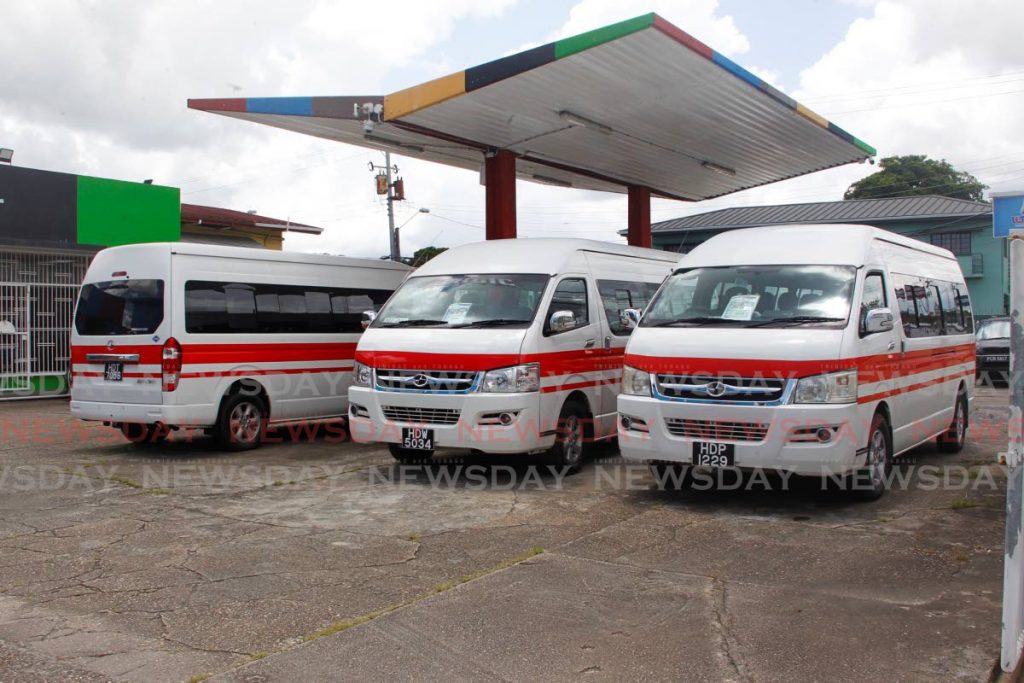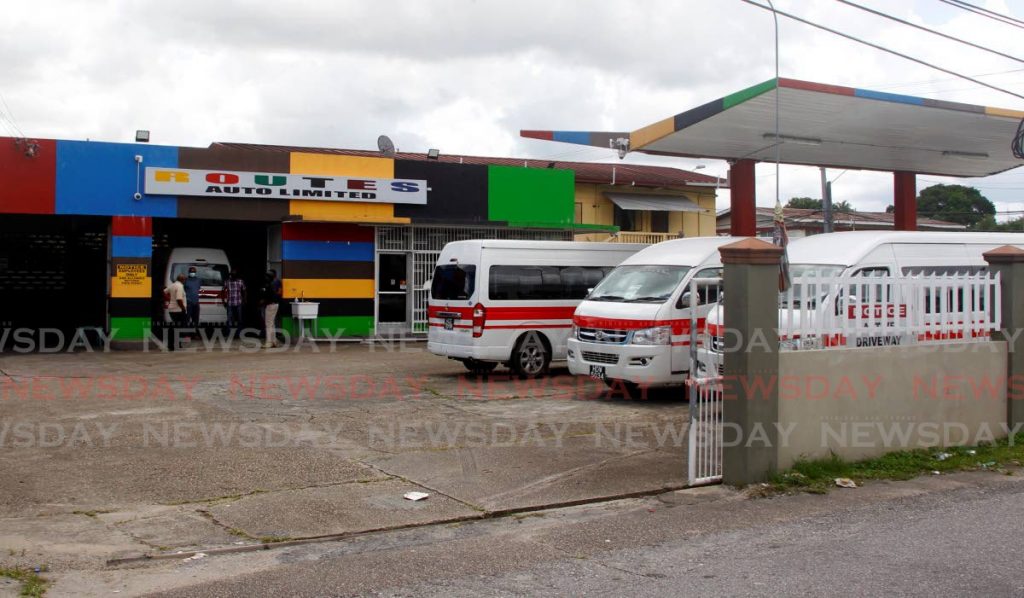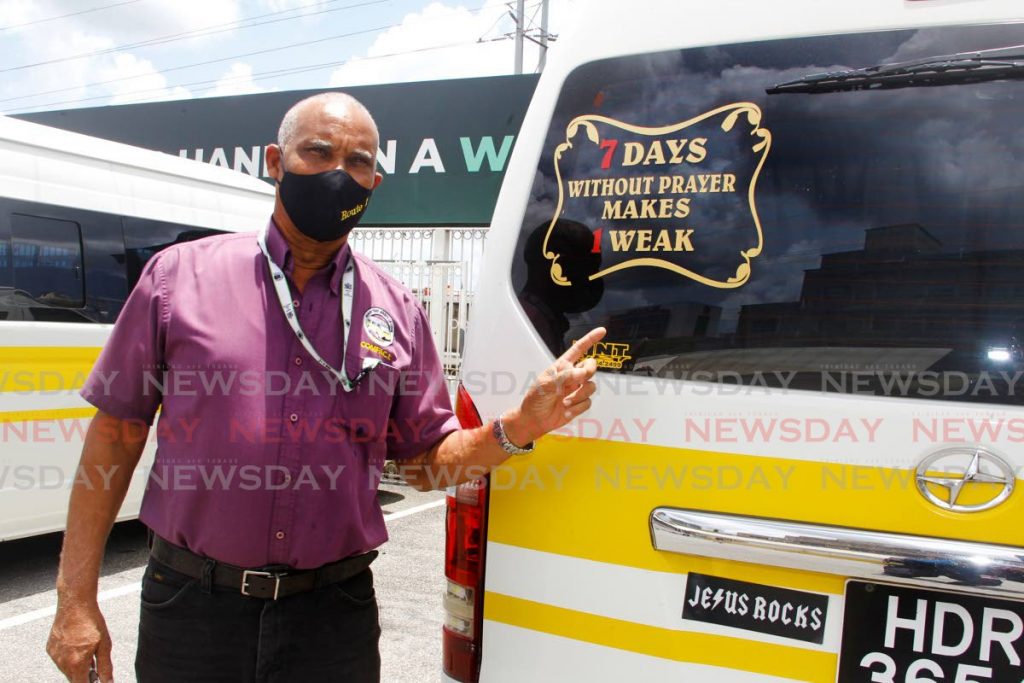Routes Auto gives green light to CNG maxi taxis

Every day, thousands of people use maxi taxis to get where they need to go in TT. Among the 5,000 maxi taxis that provide the service, a small yet growing number use CNG, whether through a bi-fuel engine, or dual fuel diesel engine.
These maxis have proven to be efficient, affordable and durable according to the Association of Maxi Taxi Drivers of TT (AMTTT).
For the past six years, the association, with the assistance of the National Gas Company (NGC), has been a key contributor in the drive to make the maxi taxi service part of the green economy through Routes Auto Ltd, a company which specialises in the import, sale and maintenance of OEM (original equipment manufacturer) CNG-powered maxi taxis.
Like other companies, Routes Auto endured difficulties in the face of the covid19 pandemic, but the leadership says they continue to serve the maxi taxi industry as a company built by "maxi men and for maxi men."
A public private partnership
In August 2015, AMTTT formed Routes Auto Ltd after years of consultation and collaboration with NGC CNG. Its executive made visits to Jiangsu, China, sourcing their flagship vehicle the Joylong A6 18-seater bi-fuel (petrol/CNG) maxi taxi, provided by Joylong Automobile Co.
The company assists maxi operators in either trading in their maxis for new ones or helping them source a new one.
The maxis are made to order and licensed as transport vehicles to serve the public in a cleaner, more efficient and cheaper manner.
The process – including building the vehicle, transporting it to TT, licensing, painting, and handing it over the driver – takes about six months. Within that time maxi operators would continue using their vehicles.
Several operators also took advantage of incentives from NGC CNG, which gave drivers a minimum of $45,000 to switch from diesel-burning vehicles to CNG.

Up until 2019, the company operated out of the Route One Maxi Taxi Association’s offices in Port of Spain. The company then converted an old NP gas station in Tunapuna into its headquarters.
“When we got this place we could see through the roof,” said chairman of Routes Auto and AMTTT president Eon Hewitt. “We rebuilt it from the ground up.”
The company’s technicians and directors were all members of the association. Their lead technician, a driver and mechanic, went to Jiangsu, China, to train in repairing and maintaining the vehicles. They also sourced the tools and equipment needed to maintain the vehicles. The company now has two technicians specialised in the maintenance and repair of CNG-powered vehicles.
The board and association leaders said Routes Auto’s journey was made possible in no small part with the assistance of NGC CNG. The board said their trips to China, training of staff, and sourcing of equipment was all done with the assistance of NGC.
“This is a great example of a public private partnership where the end users or the maxi taxi drivers were actually involved in the process from day one and continue to be in discussion with the government agency,” said Albert Lee Young, former manager of corporate services of Routes Auto. “AMTTT and Routes Auto played a major role in having CNG as an alternative fuel in TT. NGC realised that if a maxi taxi using CNG can operate efficiently, then the average person who has a car just driving to work and home gives a different perspective of how the vehicles actually work.”
Think its slow? Pass it on the road
Maxi taxi drivers on Tuesday told Business Day that Routes Auto’s Joylong 18-seaters did not only perform well, but reduced their fuel bill significantly.

Modelled from the traditional Hiace vehicles, the A6 extended the body length to 5.99 metres to accommodate up to 18 passengers. Its 3TZ and 4GA1-2 engines are capable of conversion to CNG and provides power for the clean caravans.
It is also equipped with two 100-litre CNG tanks installed to the back of the vehicle. The vehicle is supported by two double wishbone independent suspension systems at the front and variable stiffness leaf springs at the back.
Aaron Billy, a maxi taxi driver for 10 years and the owner of one of the CNG maxis for a year, said the vehicle went beyond his expectations in terms of power performance and price at the pump.
“I had an old E-24 diesel bus, and in this line of work you need to upgrade. When I heard about the offer of $45,000 to trade in for a CNG vehicle I took it. I didn’t regret getting the bus. It is a good investment. It is a first class bus and when people travel they are satisfied.”
“On a scale of one to ten I would give it a 9.5,” said Everel Archibald who has been using a CNG maxi taxi for five years. “Since purchasing the vehicle I feel as though I made an excellent investment. Even using the maxi fully loaded I get a good response from the vehicle.”
Maxi taxi drivers debunked claims made of sluggishness in the engine and fuel economy.
“When you mash with the A6 it goes running,” said Albert Lee Young, another maxi taxi owner. “I was amazed that the vehicle could run that well especially with two tanks and 18 passengers.”
He said the engine is so powerful that it can use the CNG fuel even when the maxi taxi has to go uphill, despite it being advised that one should use the gasoline when driving on an incline.
One driver also said his CNG maxi taxi, after testing the vehicle, got up to 170 km/hr.
“If you think the maxi doesn’t have any power, just try and pass it on the road,” Hewitt added.
Darren “Magic” Rivers added that his vehicle was able to run non-stop, either while driving or while idling for a maximum of eight hours on a full tank, which cost about $40 to fill.
The vehicles are also cheaper than diesel ones.

Hewitt told Business Day that other models carrying 15-seater vehicles go for around $390,000. Routes Auto’s Joylong 18-seater goes for $330,000.
He added that maintenance was also relatively cheap.
“My vehicle is only two years roughly,” Rivers said. “The maintenance is affordable because you don’t have much to do on the vehicle.”
Ensuring the vehicle is properly maintained is important for optimum performance. Hewitt said some drivers who complain about CNG maxi taxis do not maintain the vehicles.
Routes Auto said it assisted NP with the development of an engine oil for CNG vehicles which is a cleaner oil and in most cases shows up clear when a driver checks it on a dipstick. But, the oil begins to break down after a few thousand kilometres making the first oil change after about 5,000 km crucial.
Hewitt said some drivers do not prioritise that first oil change and would wait for a long time to come in for maintenance.
“The vehicles that we service here that would have a problem or two would be those who have more than one driver and have owners that are more interested in money than servicing the vehicle. You would have an owner that has a driver and he may not be interested in checking the oil in the engine. If the driver says it has oil, it has oil. If he says the brakes are good, they are good. They would not take the vehicle and drive it to make sure that it runs the way it is supposed to.”
He said about 20 per cent of the drivers do not service the vehicles the way they should be.
“The guys who service the vehicles would tell you they have no problems with the vehicles.”
Gassing up the market
The question then is, if the vehicles performs well, is cheaper, and has less maintenance costs, why aren’t more people interested?

The short answer to this is, they are.
Routes Auto said that revealed that in 2016 when the first vehicles were bought, it sold two. The next year, it sold 15. The year after it sold 21.
Even during the pandemic the company was able to sell more than 10 vehicles.
Hewitt said aside from sales, the company has also issued more than 300 quotations over their six years of operation.
Joel Browne, Routes Auto managing director, said because the company was small with limited working capital, they have to import the vehicles by order, instead of having a showroom where they are readily available.
He said this in some way hindered the company’s ability to maintain customers interest. The lengthy wait of six months to get the vehicle was also a turn off for some.
“First we have to make a down payment to the manufacturer. That down payment has to be made in US. Then they would have to manufacture the vehicle, which would take about six weeks. Then it takes another six weeks to come from China to TT then it would take a couple weeks to clear at the port and about another month for the driver to get it in his hand. The interest and demand of the vehicle was affected because it just wasn’t readily available when the drivers want it.”
“If we had that monetary capacity and we could have brought in about 30 vehicles at one time, we could have seen them gone in a short space of time.”
He added that like most businesses access to foreign exchange was also an issue. But Browne said accessing foreign exchange was addressed last year, as it was given a financial facility which included letters of credit that gave the manufacturers the assurance through the bank that the downpayment would be made within a 90-day period.
“That facility came smack dab in the middle of covid19,” Browne said. “If we had that facility in 2017 or 2018, I am sure we could have brought in more.”
NGC responds
NGC CNG told Business Day maxi taxi drivers save between $30,000 and $40,000 per year.
“CNG notes recent statements attributed to the leadership of one section of the maxi taxi association claiming saving of about 30 per cent on their fuel bill was not a saving. In providing an example, the persons indicated that before switching to CNG they would spend $200 on diesel, with a CNG switch they now spend between $130-$140 on fuel (CNG & diesel). The $60 to $70 saved represents between 30 per cent to 35 per cent daily which can translate to an annual savings of up to $18,000. How can that not be a saving?”
NGC CNG added that a switch to an OEM CNG bi-fuel maxi taxi provides owners and operators a saving of 75 per cent on their fuel bill.
It also responded to complaints of conversions from diesel to CNG, saying that while the conversions still provide savings, that type of conversion was not heavily promoted to maxi taxi drivers. It added that only a handful of drivers converted their diesel vehicles to CNG, which is not a good representation of the conversion process.
“Instead, NGC CNG in collaboration with the AMTTT developed and introduced a grant in 2015 for the purchase of an OEM CNG maxi taxi that uses 100% CNG to replace a diesel equivalent. This grant encourages maxi taxi owners to dispose of their old, inefficient diesel polluting maxi and replace it with an OEM CNG/gasoline maxi, of which several models are currently available in the country.”
NGC CNG also said it disburses the grant funding to maxi taxi drivers once all due diligence is completed. It assured that the process is thorough and only in isolated instances did drivers have to wait longer than three to four weeks for their grant funding.
“Again the maxi representatives interviewed in last week’s article, took the minority of cases, and painted a broad brush of negativity on the entire CNG maxi industry.”
NGC CNG reiterated the switch to CNG is an excellent option for high mileage drivers, giving them an opportunity to save tens of thousands of dollars annually.
“Indeed, CNG has saved all its users well over $100 million in fuel savings with the programme thus far and savings continue to increase as more users come on board.”


Comments
"Routes Auto gives green light to CNG maxi taxis"